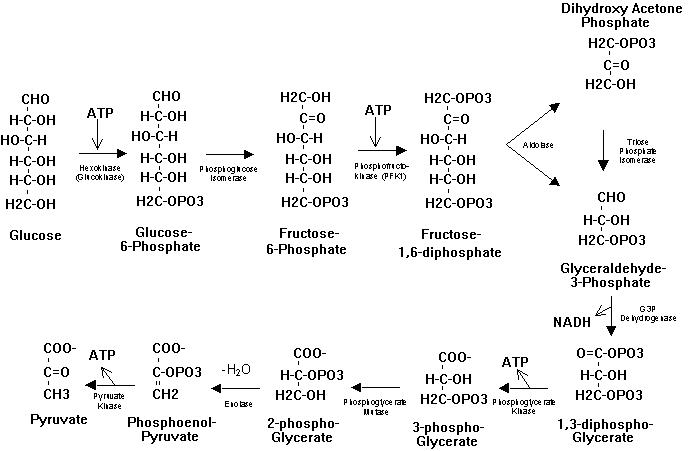Glycolysis
Glycolysis is the process by which glucose is oxidized to pyruvate (to enter TCA cycle), producing ATP
- tissues without mitochondria (RBCs, renal medulla) are entirely dependent upon glycolysis for ATP
Glycolysis takes place in two steps:
Þ Fructose-1,6-diphosphate six carbon species, requires energy
(2) Glyceraldehyde-3-Phosphate Þ Pyruvate three carbon species (two for each glucose), provides energy
The Glycolytic Pathway

Enzymes in Glycolysis
Nine main enzymes (Note: an asterix (*) indicates regulated steps)
- (1) Hexokinase
in every cell Km = 0.1, so the enzyme is usually saturated
- Glucokinase
is liver hexokinase Km = 10 mM, so liver absorbs much more sugar than other tissues
- regulated differently glucose-6-phosphate inhibits hexokinase but not glucokinase
- glucose enters cell through GLUT receptors GLUT2 (liver B cells), GLUT4 (requires insulin muscle and fat cells)
- hexokinase/glucokinase does not work in reverse, so phosphorylation effectively traps glucose inside the cell
- (2) Phosphoglucose Isomerase
reversable and unregulated driven by mass action
- *(3) Phosphofructokinase-1 (PFK-1)
irreversable,
D G << 0 first committed step to glycolysis, so very tightly controlled
- regulation: ATP (-), citrate (-) (both indicate that enough energy already) AMP (+), Fructose-2,6-diphos.(+)
- ATP and AMP both elevated in energy depleted states 2ADP
Þ ATP + AMP (adenylate kinase)
AMP rescues PFK function at high ATP levels
PFK-2 reversably makes fructose-2,6-dP from fructose-6-P when glucose levels are high
- liver isomer of PFK-2 is inhibited by cAMP (stop liver glycolysis when fasting); muscle isomer is not
(4) Aldolase reversable produces two three-carbon molecules (G3P and DHAP)
- Triose Phosphate Isomerase
interconverts G3P and DHAP
(5) G3P Dehydrogenase reversable, but driven forward by low NADH/NAD+ ratio NAD+ must be quickly regenerated
(6) 3-Phosphoglycerate Kinase produces ATP (two per glucose, since two three-carbon species were formed)
- alternate pathway: diphosphoglycerate mutase 1,3-diP-glycerate to 2,3-dP-glycerate (BPG) in RBCs
(7) Phosphoglyceromutase reversable activated by BPG in RBCs
(8) Enolase reversable
*(9) Pyruvate Kinase irreversable, D G << 0 different isoforms in muscle and liver are regulated differently
- muscle: ATP(-) already enough energy; liver: cAMP(-), alanine(-), ATP(-) stop glycolysis during fasting
- both isoforms are activated if earlier steps in glycolysis are occuring Fructose-1,6-bisphosphate(+)
Energetics of Glycolysis
Each molecule of glucose yields:
- (1) 2 ATP
two used during the six-carbon leg, but four made during the three-carbon leg
- (2) 2 NADH
since glycolysis occurs in the cytosol, it must enter the mitochondria to be used in oxidative phosphorylation
- phosphoglycerate shuttle
in muscle NADH reduces DHAP to 3-phosphoglycerol (3P-glycerol dehydr.)
- 3P-glycerol enters mito and reduces FAD
Þ FADH2 on the membrane (via flavoprotein dehydrogenase)
thus each NADH produces only 2 ATP in muscle (FADH2 is less energetic)
malate-aspartate shuttle in liver NADH reduces oxaloacetate (OAA) to malate (malate dehydrogenase)
- malate enters mitochondria, where it is made back into oxaloacetate, producing NADH
Þ OAA Þ aspartate (via aspartate transaminase); aspartate is transpoted to cytosol, then aspartate Þ OAA
thus each NADH prodcues 3 ATP in liver (NADH retained)
(3) pyruvate two principal fates:
- 1
to lactate (via lactate dehydrogenase) does not require O2, but uses 2 NADH (from above) so 0 ATP
- 2
to acetyl CoA (via pyruvate dehydrogenase complex) enter TCA cycle (12 ATP per turn) so net 24 ATP
Therefore:
Þ lactate 2 ATP
glucose + O2 Þ CO2 + H2O 36 ATP in muscle, 38 ATP in liver difference due to different NADH shuttles

